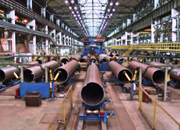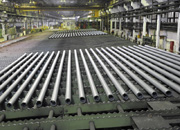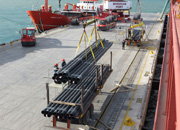Q960C straight seam steel pipe, as a high-strength low-alloy structural steel material, has demonstrated significant application value in engineering machinery, mining equipment, and bridge construction in recent years. With its excellent mechanical properties, welding process adaptability, and economic efficiency, this type of steel pipe is gradually becoming a domestic alternative to imported products of the same type.
First, the material characteristics and performance advantages of Q960C straight seam steel pipe.
Q960C belongs to the high-strength structural steel category of GB/T 16270 standard. Its minimum yield strength reaches 960MPa. Through the addition of microalloying elements such as niobium, vanadium, and titanium, combined with controlled rolling and controlled cooling processes, fine-grain strengthening and precipitation strengthening are achieved. Compared with ordinary Q355B steel pipe, Q960C has approximately 2.7 times higher strength while maintaining low-temperature impact toughness (≥27J) at -40℃. This combination of high strength and good toughness makes it particularly suitable for heavy equipment subjected to alternating loads. Companies like China Baowu Steel Group have optimized the Ceq (carbon equivalent) to below 0.48, enabling materials to maintain strength while possessing excellent weldability, thus solving the common cold cracking sensitivity problem of high-strength steel.
Second, Analysis of the Precision Manufacturing Process of Q960C Straight Seam Steel Pipes.
The production process of straight seam steel pipes embodies the precision characteristics of modern steel processing. Taking a large steel pipe company mentioned in the search results as an example, it adopts the JCOE forming process: first, the pre-leveled steel plate is molded into a "J-C-O" gradient cross-section through multi-step molding; then, the weld is formed in one step through high-frequency induction welding (HFW); finally, it undergoes online quenching at 880℃ for 30 minutes followed by tempering at 600℃. This process allows the grain size of the weld area to reach ASTM 12 or higher, and the width of the heat-affected zone to be controlled within 2mm. Of particular note is the advanced dual-stage inspection system combining ultrasonic testing (UT) and eddy current testing (ECT), capable of detecting porosity defects larger than 0.5 mm in diameter, ensuring the safety performance of the steel pipe under pressure conditions of 300 Bar.
Third, Analysis of Typical Application Scenarios of Q960C Straight Seam Steel Pipes
1. Construction Machinery: A company's newly launched SY1250H excavator boom uses Q960C straight seam steel pipes instead of the traditional forged and welded structure, achieving a 23% weight reduction while increasing service life by 40%. This lightweight design improves fuel efficiency by 15% and reduces carbon dioxide emissions by approximately 8 tons per unit per year.
2. Energy Equipment: In the manufacturing of large compressor housings for a company, the use of Φ426×25mm Q960C straight seam steel pipes increased the pressure-bearing capacity from 35MPa to 50MPa, while reducing equipment volume by 30%, making it particularly suitable for space-constrained scenarios such as offshore platforms.
3. Special Vehicle Sector: A company's new mining dump truck uses variable cross-section Q960C straight seam steel pipe laser welding technology for its frame beam, increasing the frame's torsional stiffness by 65% and successfully passing 2 million bench fatigue tests.
Fourth, Technological Breakthroughs and Domestic Substitution of Q960C Straight Seam Steel Pipes.
Previously, this material relied heavily on imports from Germany and Japan, costing as much as 23,000 yuan per ton. With domestic companies overcoming key TMCP (Thermomechanical Control Process) technologies, domestically produced Q960C straight seam steel pipes now achieve performance comparable to imported products, while costing only 60% of the price. A tunnel support project case shows that replacing imported X960 steel pipes with domestically produced Q960C saved 18 million yuan in material costs per project, and shortened the delivery cycle from 12 weeks to 4 weeks. It is worth noting that the latest NB/T 47013.3-2022 standard has raised the acceptance standards for weld seams of this type of steel pipe to the same level as the base material, promoting quality upgrades in the industry.
Fifth, the market prospects and development trends of Q960C straight seam steel pipes.
According to the China Steel Structure Association, the market demand for high-strength steel pipes is expected to exceed 3 million tons by 2025, with Q960C grade materials accounting for an estimated 15%. With the trend towards larger wind power plants, wind turbine towers over 120 meters are beginning to adopt segmented designs using Q960C straight seam steel pipes, reducing flange connection points by 40% compared to traditional Q690 materials. Meanwhile, the hydrogen energy storage and transportation sector is testing the high-pressure hydrogen compatibility of Q960C pipes with an inner surface aluminum plating treatment, potentially opening up new application opportunities.
 Threeway Steel is known as a professional supplier engaged in manufacturing and distributing a wide range of steel pipe, and our headquarter located the central part of China – Hunan and six associated factories throughout China.
Threeway Steel is known as a professional supplier engaged in manufacturing and distributing a wide range of steel pipe, and our headquarter located the central part of China – Hunan and six associated factories throughout China.
 Threeway Steel is known as a professional supplier engaged in designing, manufacturing and distribution of a wide range of steel products with the headquarter located the central part of China – Hunan and six associated factories throughout China.
Threeway Steel is known as a professional supplier engaged in designing, manufacturing and distribution of a wide range of steel products with the headquarter located the central part of China – Hunan and six associated factories throughout China.
 Threeway Steel is known as a professional supplier engaged in designing, manufacturing and distribution of a wide range of steel products with the headquarter located the central part of China – Hunan and six associated factories throughout China.
Threeway Steel is known as a professional supplier engaged in designing, manufacturing and distribution of a wide range of steel products with the headquarter located the central part of China – Hunan and six associated factories throughout China.
 Threeway Steel is known as a professional supplier engaged in designing, manufacturing and distribution of a wide range of steel products with the headquarter located the central part of China – Hunan and six associated factories throughout China.
Threeway Steel is known as a professional supplier engaged in designing, manufacturing and distribution of a wide range of steel products with the headquarter located the central part of China – Hunan and six associated factories throughout China.
 Threeway Steel is known as a professional supplier engaged in designing, manufacturing and distribution of a wide range of steel products with the headquarter located the central part of China – Hunan and six associated factories throughout China.
Threeway Steel is known as a professional supplier engaged in designing, manufacturing and distribution of a wide range of steel products with the headquarter located the central part of China – Hunan and six associated factories throughout China.

